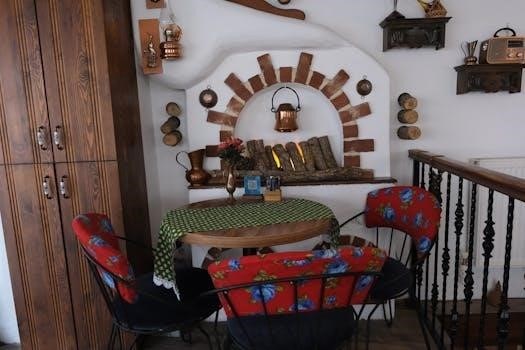
Lincoln Logs are a classic toy cherished for generations‚ offering creative building experiences. These interlocking wooden logs provide endless possibilities‚ encouraging children to design and construct various structures‚ fostering imagination and manual dexterity. Many sets include visual guides‚ though some may require online searches for manuals.
The Timeless Appeal of Lincoln Logs
The enduring charm of Lincoln Logs lies in their simplicity and ability to spark creativity. Unlike many modern toys with complex instructions‚ Lincoln Logs offer a more open-ended play experience. Children can build structures based on their own imagination‚ fostering problem-solving skills and spatial reasoning. The use of real wood adds a tactile and natural element‚ enhancing the play experience. Their longevity as a popular toy‚ spanning over a century‚ demonstrates their inherent appeal to both children and adults. Many families cherish these sets as a multi-generational toy passed down through the years. The absence of strict rules and the focus on creativity allows the child to take the lead in their play. The tangible nature of the logs also encourages hands-on learning‚ making it a valuable tool for children’s development. The combination of these factors contributes to the timeless appeal of Lincoln Logs.

The History of Lincoln Logs
Lincoln Logs were invented in 1916 by John Lloyd Wright‚ son of architect Frank Lloyd Wright. First produced in 1918‚ these interlocking logs have since become a beloved classic toy‚ cherished by generations for their simple design and creative potential.
John Lloyd Wright’s Invention
The creation of Lincoln Logs is attributed to John Lloyd Wright‚ the son of the renowned architect Frank Lloyd Wright. Inspired by the interlocking construction of the Imperial Hotel in Tokyo‚ designed by his father‚ John envisioned a toy that would similarly allow for creative and structural building. In 1916‚ he developed the concept of notched wooden logs that could interlock to form various structures. This innovative design allowed children to build cabins‚ forts‚ and other imaginative creations‚ fostering both creativity and problem-solving skills. The simplicity of the design is a key part of its enduring appeal. John Lloyd Wright’s invention has provided children with a hands-on way to learn about construction and design‚ making it a significant contribution to the world of toys. The toy was first produced in 1918‚ quickly gaining popularity and cementing its place in toy history. This innovative idea has delighted children for over a century and remains a classic toy today.
Lincoln Logs’ Longevity
The enduring appeal of Lincoln Logs is a testament to their timeless design and educational value. Introduced in 1916‚ these simple wooden logs have captivated generations of children‚ transcending trends and technological advancements in the toy industry. Their longevity can be attributed to the fundamental nature of play they encourage. Unlike many modern toys that require batteries or electronic components‚ Lincoln Logs engage children in a hands-on‚ creative building experience. The use of real wood adds to their durability and classic aesthetic‚ making them a toy that can be passed down through families. The simplicity of the interlocking logs allows for open-ended play‚ fostering imagination and problem-solving skills. The continued availability of various sets and themes‚ while staying true to the original design‚ helps maintain their relevance. The fact they are still produced and played with over a century later makes them one of the most loved and iconic toys in history‚ proving their timeless design and enduring appeal.

Understanding Lincoln Logs Sets
Lincoln Logs sets vary‚ but typically include notched wooden logs and sometimes plastic accessories. Sets range in size and complexity‚ offering diverse building experiences. Some sets focus on specific themes‚ enhancing creative play and building possibilities.
Components of a Typical Set
A standard Lincoln Logs set primarily consists of meticulously crafted real wood logs‚ designed with notches that allow for easy interlocking. These logs come in various lengths‚ providing the foundational elements for construction. In addition to the wooden logs‚ many sets include plastic components‚ such as roofs‚ chimneys‚ and fences‚ which add colorful detail and enhance the visual appeal of the finished structures. These plastic accessories often feature vibrant colors and simple designs‚ complementing the natural wood logs. Some sets also incorporate small figurines‚ like cowboys or horses‚ to further enrich the play experience and spark imaginative storytelling. The inclusion of instruction manuals is also common‚ guiding users on how to build various structures‚ though many sets rely on visual guides. The variety of components within a set‚ whether it is the classic wood logs or the additional plastic elements‚ allows for extensive creative expression and varied building projects. Furthermore‚ the consistent design and quality of the materials ensure that the sets can be used for generations‚ fostering a sense of timeless play.
Variations in Sets and Themes
Lincoln Logs sets come in a wide array of variations‚ each catering to different interests and building complexities. Some sets focus on classic frontier themes‚ complete with logs‚ roofs‚ and figures reminiscent of the Wild West. These sets often evoke a sense of historical play‚ allowing children to recreate scenes from the past. Other sets may feature more modern designs‚ incorporating unique plastic components and vibrant colors to create more contemporary buildings. Variations also exist in the size and number of pieces included‚ ranging from smaller sets perfect for younger children to larger‚ more elaborate sets intended for advanced builders. Certain themed sets might include specific accessories such as train tracks‚ allowing for the construction of scenes with moving elements. Furthermore‚ special edition sets‚ often released to celebrate anniversaries‚ may include unique components and packaging‚ appealing to collectors and longtime fans. These variations in sets and themes ensure that there is a Lincoln Logs experience for every child‚ catering to different ages‚ skill levels‚ and preferences‚ and further expanding the creative possibilities for playtime. Each set is designed to encourage imaginative play and building skills‚ regardless of theme or size.

Using Lincoln Logs Instructions
Lincoln Logs instructions are often visually based‚ using pictures to guide the building process. These instructions are crucial for constructing specific models‚ and can sometimes be found in included booklets or online‚ offering varied building ideas.
The Importance of Visual Guides
Visual guides are paramount when engaging with Lincoln Logs‚ as they often replace written instructions. These visual aids‚ typically presented as diagrams or pictures‚ offer a clear pathway for constructing models‚ especially for younger builders who might struggle with text-based directions. The simplicity of these guides allows children to easily grasp how the logs should interlock and fit together‚ fostering independent play and problem-solving skills. Furthermore‚ visual guides enable users to comprehend complex structures by breaking them down into manageable steps‚ facilitating a smooth and enjoyable building experience. The absence of text also makes these guides universally accessible‚ transcending language barriers and encouraging collaborative play among diverse groups. They promote creativity by providing a foundation that builders can then diverge from as they gain confidence and experience. These visual instructions are not just about replicating models; they encourage thinking in three dimensions and developing spacial reasoning through hands on activity. Consequently‚ visual guides are an essential and integral component of the Lincoln Logs experience‚ promoting fun and educational value. They often serve as a catalyst for exploration and innovation‚ making the building process intuitive and rewarding for all users‚ young and old alike.
Finding Instruction Manuals Online
Locating instruction manuals for Lincoln Logs online has become increasingly convenient‚ thanks to various digital resources. Many websites and online communities dedicated to toys and vintage items often host scanned versions of original instruction booklets. These digital manuals are typically available as PDF files‚ making it easy to download and view them on a variety of devices. Searching specific keywords like “Lincoln Logs instructions PDF” or “vintage Lincoln Logs manual” can yield numerous results. Additionally‚ online retail platforms and auction sites frequently showcase product listings that might include scans or photos of the original instructions. Fan forums and social media groups often share instruction manuals‚ or helpful building tips. Some companies also maintain archives of instructions for older sets on their official websites‚ demonstrating a commitment to the product’s legacy. These online resources offer a wealth of information‚ enabling builders to recreate classic designs or gain inspiration for their own unique creations. Moreover‚ video tutorials on platforms like YouTube can also provide visual guidance‚ complementing the use of PDF manuals. When searching‚ it’s important to verify the authenticity and completeness of the manual‚ to fully enjoy the building experience‚ ensuring you have access to all the instructions necessary to bring the full play value to your Lincoln Logs.

Building with Lincoln Logs
Building with Lincoln Logs involves simple stacking and interlocking techniques. Start with basic structures like cabins‚ then explore advanced designs using visual guides. Creativity is key to constructing unique and imaginative creations‚ enhancing the building experience.
Basic Building Techniques
The fundamental building technique with Lincoln Logs involves interlocking the notched ends of the logs. Begin by creating a stable base‚ typically a square or rectangle‚ using the longest logs. Ensure that each log is firmly placed‚ with the notches fitting snugly into the grooves of the log below. This creates a sturdy foundation for your structure. As you build upwards‚ alternate the direction of the logs to enhance stability and create a more robust wall. For corners‚ overlap the logs by placing them at right angles to each other. This overlapping method is crucial for constructing strong and secure structures. Remember to use the various log lengths to your advantage‚ building walls and creating openings. Start with simple structures like basic cabins or small fences to get a feel for the interlocking system. You may need to try different combinations of log lengths to achieve the desired height and shape. Visual guides or pictures can help beginners to grasp the fundamental steps. Patience and experimentation are key to mastering the basic techniques.
Advanced Building Ideas
Once familiar with basic techniques‚ delve into more intricate structures. Explore building multi-story cabins‚ incorporating towers and balconies. Use shorter logs to create detailed windows or door frames‚ adding realism to your designs. Try constructing angled roofs‚ experimenting with different log arrangements to achieve the desired slope. Consider adding extensions‚ like porches or stables‚ to your main building. Combine multiple Lincoln Logs sets to create larger‚ more complex layouts‚ such as whole frontier towns. Use your creativity to craft unique elements‚ like fences or corrals‚ adding detail and dimension. Think about using the plastic accessory pieces‚ if available‚ to enhance the visual appeal. For example‚ incorporating plastic roofs or decorative elements will add further detail. Experiment with layering logs to create different textures and patterns on the walls. Research various designs online or in instruction manuals for inspiration on new ways to use your logs. Don’t be afraid to deviate from the instructions and explore your unique style.